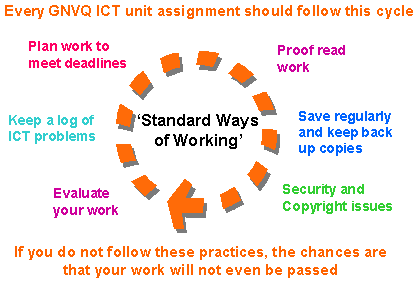Standard Ways Of Working

INDEX
1. Managing work
2. Keeping information secure
3. Accuracy and Readability
4. Data Protection
5. Organisations and standard formats
6. Working safely
There are set standards of working which apply throughout
all of the Intermediate Part One GNVQ ICT units. They apply in detail
in Unit A, but apply also throughout all of the units of this course.
It is expected that these standards should be followed and adhered to
as a standard method of working in ICT.
The following in summary are the standards which should
be followed:
1 Managing work
Management of ICT work is important:
- students need to plan and work to deadlines
- use tab and indent settings so data can be easily changed
- use sensible file names
- store files in a directory/folder structure
- keep a log of ICT problems and how they are solved
- check and evaluate work suggesting improvements
(Back to top of page)
2. Keeping information
secure
Information must be protected from loss or misuse in ICT:
- protecting information from theft, loss, viruses, fire
- protecting confidential information
- respecting copyright
- saving work regularly
- backing up work
(Back to top of page)
3. Accuracy
and readability
All documents and especially formal ones should be accurate. Use a
spell-checker:
- for incorrectly spelt words
- for repeated words (eg 'and and')
Use a grammar-checker:
- for agreement of subject and verb
- to find level of reading difficulty of work
- to write mainly in a certain style
- to detect sentences with two full-stops
- to detect missing capital letters at the start of sentences
Also:
- use print preview to check the layout of documents
- proof-read documents both on screen and in printed form
- check document makes sense and meets its purpose
(Back to top of page)
4. Data Protection
Organisations have responsibilities to follow the Data
Protection Act 1998. Anyone processing personal data must comply
with the eight enforceable principles of good practice. They say that
data must be:
- fairly and lawfully processed;
- processed for limited purposes;
- adequate, relevant and not excessive;
- accurate;
- not kept longer than necessary;
- processed in accordance with the data subject's rights;
- secure;
- not transferred to countries without adequate protection.
(Back to top of page)
5. Organisations and standard
formats
Organisations often have their own standards of document layout. They
will also have rules on confidentiality and security of information.
Students need to learn importance to organisations of:
- using common standards of document layout eg letter and memo
- write sample minutes and agendas in a specified layout
- proof-read documents using standard symbols for omissions and corrections
(Back to top of page)
6. Working safely
All organisations and users of ICT should be aware of potential hazards
and health risks:
- eye strain
- radiation
- working environment (ergonomics)
- repetitive strain injury (RSI)
- physical stress
- data overload syndrome
- electrical hazards
- fire
- obstruction
(Back to top of page)
|
